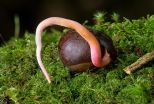(Press-News.org) Washington, D.C. - November 19, 2014 - Lumosity is presenting new research today at the 2014 Society for Neuroscience conference on how lifestyle factors such as sleep, mood and time of day impact cognitive gameplay performance. The study, titled "Estimating sleep, mood and time of day effects in a large database of human cognitive performance," analyzed over 60 million data points from 61,407 participants and found that memory, speed, and flexibility tasks peaked in the morning, while crystallized knowledge tasks such as arithmetic and verbal fluency peaked in the afternoon. Overall, they found that game performance for most games was highest after seven hours of sleep and with positive moods.
"We were able to uncover these subtle differences in individual game play performance because of the diversity and depth of our online platform," Daniel Sternberg, Ph.D., Data Scientist at Lumosity and lead author of the study. "These findings, combined with other health and lifestyle data, have the potential to provide clear and actionable insights into how an individual's daily life can impact cognitive performance."
Participants completed 100 or more daily surveys on sleep ("≤5" to "9+" hours of sleep) and mood (very bad, bad, neutral, good, or very good) over the course of a year. Gameplay performance data from nine popular Lumosity games, each challenging a distinct cognitive ability, and these surveys were analyzed to understand within-person effects and control for individual differences.
Following are the nine games and the order of their peak performance times throughout the day, with the training task in parentheses:
7:00 - 9:00a.m., Pinball Recall (working memory)
9:00 - 11:00a.m., Color Match (stroop task)
9:00 - 11:00a.m., Ebb and Flow (task switching)
10:00 - noon, Memory Matrix (visuospatial memory)
10:00 - noon, Speed Match (N-back)
10:00 - noon, Lost in Migration (flanker task)
1:00 - 3:00p.m., Word Bubbles Rising (verbal fluency)
2:00 - 4:00p.m., Raindrops (speeded arithmetic)
6:00 - 8:00p.m., Chalkboard Challenge (arithmetic reasoning)
This study suggests that there are subtle individual differences in game play performance that may be impacted by time of day, sleep, and mood. In addition, participants' beliefs about when and how well they will perform are in line with their actual performance results. Sleep effects built on previous findings (Sternberg et al 2013), and suggest there may be a way to optimize the scheduling of different tasks based on individual differences. Future studies can combine these findings with the growing health and lifestyle data from smartphones and wearable devices to help individuals and researchers better understand the relationships between our daily lives and cognitive performance.
INFORMATION:
About Lumosity's Human Cognition Project
The Human Cognition Project is Lumosity's research arm. The effort supports both in-house internal data science research at Lumosity, as well as collaborations with external academic researchers who use Lumosity products to study a broad range of topics. Lumosity currently works with 63 researchers at 47 institutions, in 6 countries, on 62 ongoing projects. For more information, please visit: http://www.lumosity.com/hcp/.
An international team of scientists, coordinated by a researcher from the U. of Granada, has found that seed dormancy (a property that prevents germination under non-favourable conditions) was a feature already present in the first seeds, 360 million years ago.
Seed dormancy is a phenomenon that has intrigued naturalists for decades, since it conditions the dynamics of natural vegetation and agricultural cycles. There are several types of dormancy, and some of them are modulated by environmental conditions in more subtle ways than others.
In an article published in the ...
Quasars are galaxies with very active supermassive black holes at their centres. These black holes are surrounded by spinning discs of extremely hot material that is often spewed out in long jets along their axes of rotation. Quasars can shine more brightly than all the stars in the rest of their host galaxies put together.
A team led by Damien Hutsemékers from the University of Liège in Belgium used the FORS instrument on the VLT to study 93 quasars that were known to form huge groupings spread over billions of light-years, seen at a time when the Universe ...
PROVIDENCE, R.I. [Brown University] -- A widely presumed problem of aging is that the brain becomes less flexible -- less plastic -- and that learning may therefore become more difficult. A new study led by Brown University researchers contradicts that notion with a finding that plasticity did occur in seniors who learned a task well, but it occurred in a different part of the brain than in younger people.
When many older subjects learned a new visual task, the researchers found, they unexpectedly showed a significantly associated change in the white matter of the brain. ...
Professor Dan Davis and his team at the Manchester Collaborative Centre for Inflammation Research, working in collaboration with global healthcare company GSK, investigated how different types of immune cells communicate with each other - and how they kill cancerous or infected cells. Their research has been published in Nature Communications.
Professor Davis says: "We studied the immune system and then stumbled across something that may explain why some drugs don't work as well as hoped. We found that immune cells secrete molecules to other cells across a very small ...
A recent study by an Indiana University researcher has found that adolescents' alcohol use is influenced by their close friends' use, regardless of how much alcohol they think their general peers consume.
Jonathon Beckmeyer, assistant professor in the Department of Applied Health Science at the IU School of Public Health-Bloomington and author of the study, said his research generally focuses on the onset of teen alcohol use and how their social relationships shape those experiences.
"We've known for a long time that friends and peers have an influence on individual ...
SAN FRANCISCO, Nov. 19, 2014 -- Hox genes are master body-building genes that specify where an animal's head, tail and everything in between should go. There's even a special Hox gene program that directs the development of limbs and fins, including specific modifications such as the thumb in mice and humans. Now, San Francisco State University researchers show that this fin- and limb-building genetic program is also utilized during the development of other vertebrate features.
The discovery means this ancient genetic program is employed in a variety of features beyond ...
A new study, published online in Brain: A Journal of Neurology today, followed 43,368 individuals in Sweden for an average of 12.6 years to examine the impact of physical activity on Parkinson's disease risk. It was found that "a medium amount" of physical activity lowers the risk of Parkinson's disease.
Karin Wirdefeldt of the Karolinska Institutet in Stockholm and her colleagues used the Swedish National March Cohort to analyse comprehensive information on physical activity of all kinds. They assessed household and commuting activity, occupational activity, leisure ...
A new study led by researchers at King's College London in collaboration with the US Consortium of Food Allergy Research and the University of Dundee has found a strong link between environmental exposure to peanut protein during infancy (measured in household dust) and an allergic response to peanuts in children who have eczema early in life.
Around two per cent of school children in the UK and the US are allergic to peanuts. Severe eczema in early infancy has been linked to food allergies, particularly peanut allergy.
The study, published in the Journal of Allergy ...
New research on a number of Canadian lakes show that historical acid deposits as a result of industry have greatly reduced calcium levels in the water - dramatically impacting populations of calcium-rich plankton such as Daphnia water fleas that dominate these ecosystems.
Falling calcium levels mean Daphnia cannot get the nutrients they need to survive and reproduce, and are consequently consuming less food and becoming more susceptible to predators, leaving more algae for other organisms to feed on.
This has left a small jelly-clad organism called Holopedium to take ...
People with airway diseases, including asthma and chronic obstructive pulmonary disease (COPD), have a higher incidence of inflammatory bowel disease, such as Crohn's disease and ulcerative colitis, according to the findings of a new study.
The research, which is published online today (19 November 2014) in the European Respiratory Journal, is the first population-based study to examine the association between airway diseases and the incidence of bowel disease. The news comes on World COPD Day, which aims to improve awareness and care of COPD.
The results showed that ...



